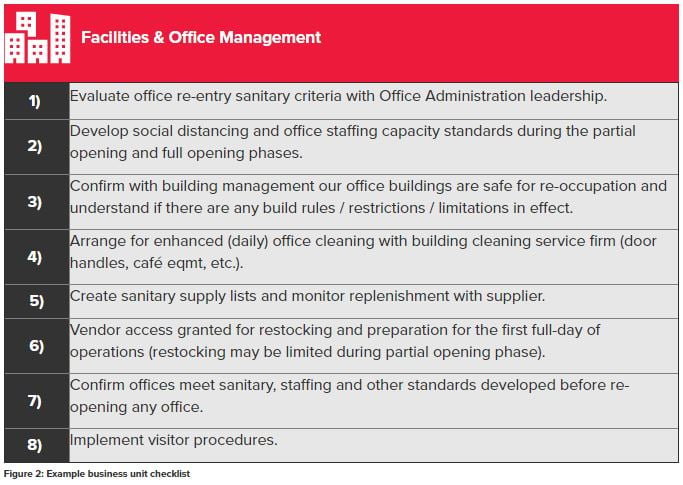 As the response to the COVID-19 pandemic progresses, many companies have established operational crisis management teams and adjusted to global restrictions on work and movement. Executives are now beginning to ask the question: How are we going to return to work?
As the response to the COVID-19 pandemic progresses, many companies have established operational crisis management teams and adjusted to global restrictions on work and movement. Executives are now beginning to ask the question: How are we going to return to work?
How companies should plan to return to work and emerge from COVID-19 stronger and smarter.
As of April 2020, some countries are starting to ease restrictions, allowing for more freedom of movement and the reopening of specific industries. In the United States, The White House has announced guidelines for re-opening the nation in a three-phased approach. These guidelines include thresholds for states to satisfy in the following areas: trajectory of reported symptoms; trajectory of reported cases; and ability for hospitals to care for patients and provide ongoing testing.
Additionally, multiple groups of governors have formed regional coalitions to coordinate reopening their states in a unified way. While it is challenging to predict when each country and U.S. state will begin to return to the workplace, many predictions point toward restrictions being lifted gradually over the next few months, depending on your location.
Regardless of precisely how governments decide to ease their restrictions, companies need to plan for an orderly and thoughtful approach to returning to work. There are three crucial steps to accomplishing this:
- Build a return-to-work plan.
- Work through the stages of partial and full operations.
- Increase resilience through monitoring for possible virus resurgence, completion of after-action reports, and program enhancements.
By doing this carefully and methodically, businesses can begin the process of restoring operations while also ensuring that they do not take one step forward and two steps backward in returning to work.
Build a return-to-work plan
Companies first need to consider the structure in which a return-to-work plan will be created. That structure will need to include identifying stakeholders; outlining authorities and decision trees; defining critical information requirements; identifying assumptions and variables; and, of course, creating detailed execution checklists for individual business units.
It’s essential to examine each part of the return-to-work program in detail:
- Identifying stakeholders: Most of the critical stakeholders may already be members of the Crisis Management Team. Members should include representatives from major business units and support functions.
- Outlining authorities and decision trees: As your company prepares to make return-to-work decisions, it is important that a decision tree is outlined in advance and that the company agrees on who has the authority to make those decisions. At a minimum, a company will need to answer three basic questions before returning to work. Those questions are:
- Can we do it? Is physical access possible through government easing of restrictions or landlord policies?
- Should we do it? Is it safe for staff to commute to and occupy a given work site? Additionally, are there supplemental government restrictions like the required use of personal protective equipment (PPE) that the company must provide for occupants?
- How will we do it? Who within the company makes the final decision to open a worksite, and what are the steps (checklist items) the business units will need to follow?



.png.aspx)

- Identifying variables: Any lifting of work and movement restrictions will likely occur in a phased approach. Governments and agencies will closely monitor infection cases and use that information to determine next steps to further ease restrictions or revert to prior levels. Some of the variables companies will need to consider are:
- Countries will only begin to ease work and movement restrictions when they see consistent reductions in new infections and are comfortable that they have available medical capabilities and hospital beds to handle any potential resurgence.
- In the U.S., individual states will start to return to work in segments (coastal states first with interior states to follow). Additionally, state governors are likely to extend restrictions beyond federal government deadlines due to the differences in when peak infection cases are reached.
- Restrictions are likely to remain in the workplace, and it is possible to see government orders that could require a reduction of in-person workforce by half, staggered work schedules, or some other measures to keep occupancy low while the effects of returning to work are measured in any potential new infection cases.
- Guidance or government orders may include parameters around which segments of the population can work first (e.g., low-risk and immune persons may be allowed to return first, while higher-risk populations will be required to remain at home).
- Some governments are requiring PPE for employees (e.g., China, France, and, in the U.S., New Jersey, New York, and some counties in California and Florida). In these cases, companies will need to prepare for and provide the required equipment before staff are allowed back into the work site. Lead times for this equipment can be very long, so advanced planning is required.
- Manufacturing and pharmaceutical equipment may require re-calibration and, in some cases, re-certification by the Food and Drug Administration (or local equivalent). Lead times for these processes could extend many weeks or months.
- Finally, companies will need to determine what other government regulations are required of them prior to opening a work site. For example, in Alameda County, California, there is currently a regulation requiring employers to post notifications to the buildings informing staff of the potential dangers that may still exist.
- Creating detailed execution checklists: For individual business units, both business unit and support function checklists will need to be created to help ensure proper steps are completed prior to staff returning to a work site. Additionally, critical third parties must be accounted for when preparing to return to work.

Working through the four stages
A return-to-work plan should account for four main stages and allow for a clear roadmap in moving from a (1) current state, to a (2) partial or limited opening, to a (3) full resumption of operations at capacity. The fourth stage accounts for the need to continue to monitor for virus resurgence. This allows for a diagnosis of how the company performed during the crisis and how it will improve going forward.
Download the PDF Version of Figure 3
The situation, objectives, indicators, and actions should be clearly defined for each of the four stages that a company expects to move through during the return-to-work process. Those elements are detailed as follows:
- Situation – Parameters are established to help define the given stage. This is especially helpful in determining when a company can begin to move from the partial opening to the full opening stage.
According to World Health Organization director-general Tedros Adhanom Ghebreyesus: “The last thing any country needs is to open schools and businesses only to be forced to close them again because of a resurgence.”
Source: https://www.reuters.com/article/us-health-coronavirus-wuhan-secondwave/beware-second-waves-of-covid-19-if-lockdowns-eased-early-study-idUSKBN21D1M9 - Objectives – A company articulates what is most important in each stage. It could be maintaining cash flow, re-establishing connections with clients and customers, re-evaluating supply chains, or completing a look back at the event with an eye toward future maturity.
- Indicators – This information is gathered from both government orders and agency guidance. It informs the company what is or is not allowed from a movement, work, or health and safety perspective.
- Actions – Finally, companies should outline how they will act within each stage. This may take the form of specific actions related to People, Process, and Technology.
The final stage of the return-to-work plan is to monitor and prepare. Here it is incumbent on companies to continue to monitor for any resurgence in the virus, identify changes to government restrictions and agency guidance, and better prepare the company to be more resilient toward future disruptions. This is also the stage where companies should do a “look back” to evaluate if any controls were relaxed during the work-from-home period.
Figure 4: Components of Operational Resiliency
There is growing concern among academics that a second wave of virus infection cases may occur later this year. Given that possibility, companies should take full advantage of the expected break over the summer and early fall months to begin to perform after-action reports and outline a plan for improvements. Those in highly regulated industries (e.g., Financial Services, Pharmaceutical) should further prepare for regulatory inquiries on how they are planning to address gaps. Regardless of industry, it is always better to show the Board and regulators (if any) that gaps have been self-identified, remediation programs outlined, and resources allocated.
This will also be the time for companies to build a consolidated operational resiliency function. In this environment, resiliency components are no longer siloed but are integrated and provide end-to-end recoverability regardless of the next business interruption.
Conclusion
As companies continue to navigate these uncharted waters, it is essential to understand that business may fundamentally change when we come out of this. A return to “business as usual” may also be a return to a new normal where we re-evaluate how we work, where we work, how we interact with customers, and where our products are made. Supply chains and concentration risks will be reassessed, and executives will begin to evaluate outsourcing and the use of low-cost locations with more of a risk lens and not merely a cost-cutting lens.
Like every systemic shock to the economy, winners and losers will emerge. One need only look to the long list of defunct internet companies from the late 1990s or the more recent list of white-heeled boutique banks that didn’t make it out of the 2008 financial crisis. In most cases, the firms that emerged had strong risk management programs and decisive leaders who executed on clearly defined recovery plans.
That is why now is the time for companies to begin working on the following three return-to-work steps:
- Build a return-to-work plan.
- Work through the stages of partial and full operations.
- Increase resilience through monitoring for possible virus resurgence, completion of after-action reports, and program enhancements.
For more information on the above article or other business tax services, contact Jessica L. Pagan, CPA by calling (334) 887-7022 or by leaving us a message below.
This article originally appeared in BDO USA, LLP's Insights/Advisory newsletter. Copyright 2020 BDO USA, LLP. All rights reserved. www.bdo.com







